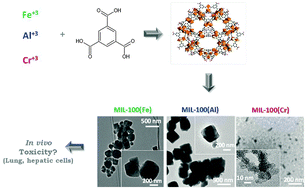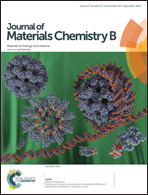In vitro biocompatibility of mesoporous metal (III; Fe, Al, Cr) trimesate MOF nanocarriers†
Abstract
The high porosity and versatile composition of the benchmarked mesoporous metal (Fe, Al, Cr) trimesate metal–organic frameworks (MIL-100(Fe, Al, Cr)) make them very promising solids in different strategic industrial and societal domains (separation, catalysis, biomedicine, etc.). In particular, MIL-100(Fe) nanoparticles (NPs) have been recently revealed to be one of the most promising and innovative next generation tools enabling multidrug delivery to overcome cancer resistance. Here, we analyzed the in vitro toxicity of the potential drug nanocarrier MIL-100(Fe) NPs and the effect of the constitutive cation by comparing its cytotoxicity with that one of its Cr and Al analogue NPs. Lung (A549 and Calu-3) and hepatic (HepG2 and Hep3B) cell lines were selected considering pulmonary, ingestion or intravenous exposure modes. First, the complete physicochemical characterization (structural, chemical and colloidal stability) of the MIL-100(Fe, Al, Cr) NPs was performed in the cell culture media. Then, their cytotoxicity was evaluated in the four selected cell lines using a combination of methods from cell impedance, cell survival/death and ROS generation to DNA damage for measuring genotoxicity. Thus, MIL-100(Fe, Al, Cr) NPs did not induce in vitro cell toxicity, even at high doses in the p53 wild type cell lines (A549 and calu-3 (lung) and HepG2 (liver)). The only toxic effect of MIL100-Fe was observed in the hepatocarcinoma cell line Hep3B, which is stress sensitive because it does not express TP53, the guardian of the genome.

- This article is part of the themed collection: 2015 Journal of Materials Chemistry B Hot Papers

 Please wait while we load your content...
Please wait while we load your content...